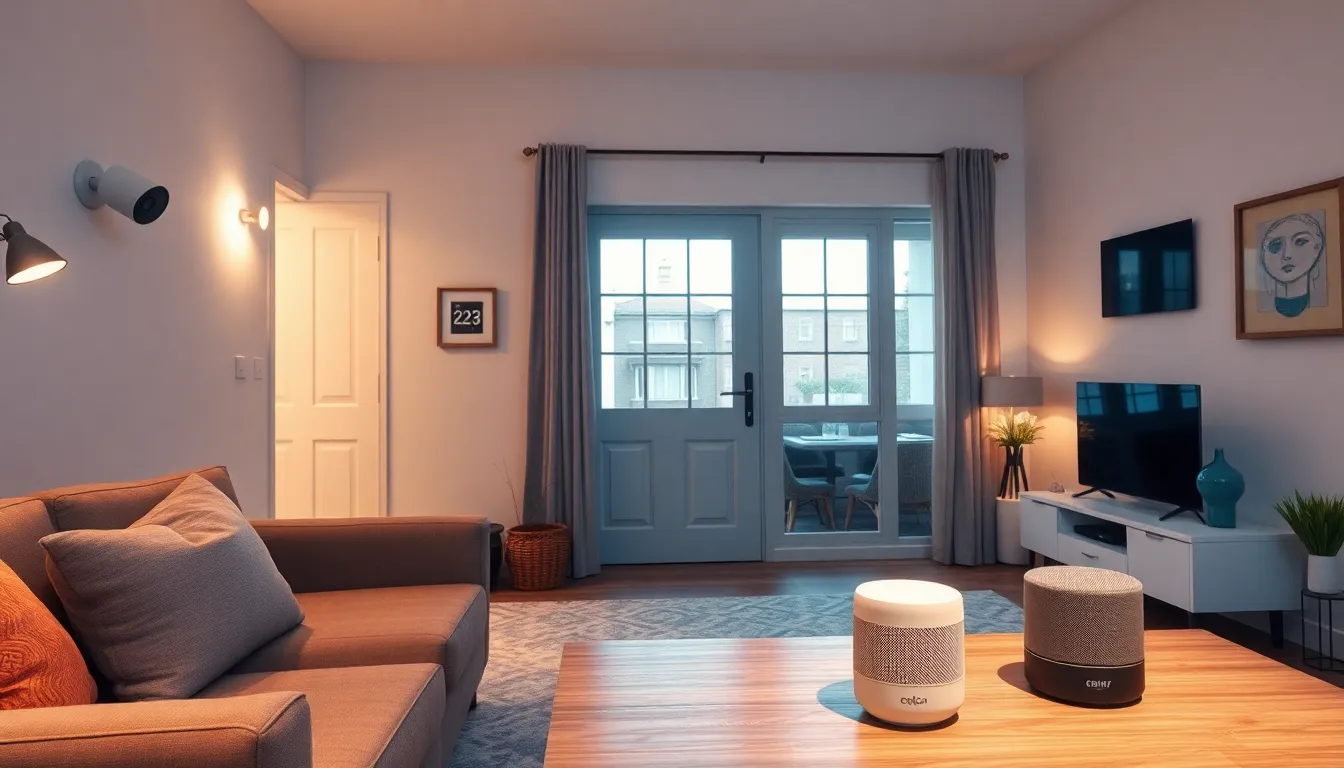Imagine walking into your home and having the lights dim, the thermostat adjust, and your favorite playlist start playing—all without lifting a finger. Sounds like something out of a sci-fi movie, right? Welcome to the world of home automation products, where convenience meets innovation. These nifty gadgets not only make life easier but also add a sprinkle of magic to everyday routines.
Table of Contents
ToggleOverview of Home Automation Products
Home automation products encompass a wide range of devices designed to streamline and enhance daily living. Various categories include lighting control systems, smart thermostats, security cameras, and voice-activated assistants. Each product type plays a specific role in improving convenience and energy efficiency.
Smart lighting systems allow users to adjust brightness and color settings remotely or automate them based on preferences. Automated thermostats learn user schedules and adjust temperatures accordingly, promoting energy savings. Security products include motion sensors, video doorbells, and surveillance cameras, providing enhanced safety and peace of mind.
Voice-activated assistants serve as central hubs for managing multiple devices. By responding to commands, these assistants simplify user interactions while controlling everything from entertainment systems to climate settings. Users can integrate home automation products through a mobile app or a voice command, ensuring seamless operation.
Many products incorporate compatibility features for different platforms, allowing devices from various manufacturers to work together. Wi-Fi connectivity enables remote access from smartphones or tablets, making it simple to monitor and control home settings from anywhere.
Additionally, the rise of energy-efficient models contributes to reducing overall environmental impact. Many manufacturers prioritize sustainability in their designs. Smart plugs and energy monitors help users track energy consumption in real-time, allowing for informed decisions on usage.
With the continuous advancements in technology, home automation products evolve rapidly, addressing user needs and preferences. They create a more personalized living experience, presenting users with tailored solutions to enhance their quality of life.
Types of Home Automation Products

Home automation products encompass various technologies that enhance convenience, security, and energy efficiency within a household. Four primary categories include smart lighting, security systems, smart thermostats, and voice assistants.
Smart Lighting
Smart lighting systems allow users to control brightness, color, and schedules through smartphones or voice commands. Options range from smart bulbs to entire lighting fixtures. Products like Philips Hue and LIFX provide adjustable settings that cater to mood and energy conservation. Automated lighting responds to user behavior, turning on or off as needed. Some systems integrate with motion sensors for enhanced convenience and safety.
Security Systems
Security systems offer a robust solution for protecting homes. They include features like motion detection, video surveillance, and remote access. Brands such as Ring and Arlo present cameras that send alerts and stream live footage to mobile devices. Many systems also incorporate doorbell cameras for monitoring entrances. Advanced features include integration with smart locks, allowing for comprehensive security management from a single app.
Smart Thermostats
Smart thermostats optimize temperature control within homes, learning user preferences and schedules over time. Devices like the Nest Learning Thermostat adjust heating and cooling automatically, saving energy while maintaining comfort. Focus on energy efficiency and utility savings marks these products as essential in modern homes. Some models come equipped with remote control capabilities, enabling users to adjust settings while away.
Voice Assistants
Voice assistants serve as centralized hubs for controlling various smart devices. Products like Amazon Echo and Google Nest allow users to issue spoken commands for lighting, music, and security systems. Integration with numerous third-party devices enhances compatibility and usability. These assistants also provide information, reminders, and control of routines, streamlining daily tasks and enhancing convenience.
Benefits of Home Automation Products
Home automation products deliver numerous advantages that improve daily life. Users experience increased convenience, enhanced energy efficiency, and heightened security within their homes.
Convenience and Control
Smart technologies provide effortless control over various home functions. Users can manage lighting, thermostats, and appliances from smartphones or voice commands. Devices like smart lighting systems set the mood with just a tap or a word. Automated routines streamline daily habits, ensuring lights turn off when leaving and adjust temperatures before arriving home. Real-time monitoring offers additional peace of mind, allowing users to check on their home from anywhere.
Energy Efficiency
Home automation products significantly contribute to energy savings. Smart thermostats adjust heating and cooling based on user behavior, optimizing energy usage and reducing bills. These devices monitor patterns and refine settings accordingly. Automated lighting systems dim or turn off when not needed, minimizing electricity consumption. Many products also provide usage reports, guiding homeowners to make more efficient choices and promoting sustainability.
Enhanced Security
Security becomes more effective with home automation systems in place. Smart cameras and motion sensors monitor activity around the house, offering instant alerts to users. Remote access allows for live video feeds, letting homeowners check in at any time. Integration with alarm systems adds another layer of protection, providing notifications during suspicious events. Products like video doorbells enable two-way communication, ensuring users can securely interact with visitors from anywhere.
Challenges and Considerations
Home automation products present several challenges and considerations that users need to address before implementation.
Compatibility Issues
Compatibility issues can arise when integrating various home automation products. Different brands might use unique communication protocols, making seamless operation difficult. Smart lighting, security systems, and thermostats require careful selection to ensure they work together effectively. Users often find that solutions that work with one platform may not support others, limiting device interchangeability. Researching compatibility across different ecosystems, such as Google Home or Amazon Alexa, helps avoid these conflicts. Additionally, some newer products may not support older devices, complicating upgrades or expansions to existing setups.
Privacy Concerns
Privacy concerns frequently surface when adopting home automation technologies. Data collected from smart devices, including user habits and routines, may be vulnerable to breaches if adequate security measures aren’t in place. Unauthorized access to security cameras and voice assistants can also compromise sensitive information. Users must evaluate each product’s privacy policies to understand how data is stored and shared. Implementing strong passwords, using two-factor authentication, and regularly updating software can mitigate these risks. Addressing these concerns proactively ensures that individuals can enjoy the benefits of automation without compromising their security.
Home automation products represent a significant leap forward in enhancing everyday life. With the ability to control lighting, temperature, and security from a single device, users can experience unparalleled convenience. The integration of these technologies not only simplifies daily routines but also promotes energy efficiency and sustainability.
As advancements continue, the future of home automation looks promising. Users are encouraged to explore various products and find solutions that fit their specific needs. By embracing these innovations, individuals can transform their living spaces into smart homes that prioritize comfort and security. The journey into home automation is just beginning, and the possibilities are endless.






